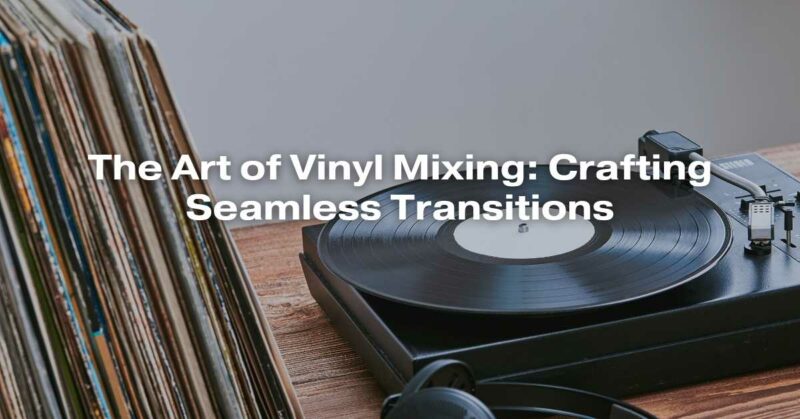Vinyl mixing, an age-old art form in the realm of DJing, has seen a resurgence in recent years, despite the digital revolution that has transformed the music industry. The tactile nature of vinyl records, the warm analog sound they produce, and the challenge they pose to DJs have all contributed to their enduring appeal. One of the most fundamental skills in vinyl DJing is the art of crafting seamless transitions between tracks. In this article, we’ll explore the techniques and nuances that go into making those perfect blends, the hallmark of a skilled vinyl DJ.
The Magic of Vinyl
Vinyl records offer a unique experience that digital formats often struggle to replicate. Each record is a physical object with its grooves, and DJs have to engage with them physically, giving them a more tangible connection to the music. This physicality translates into a heightened sense of control over the music, allowing DJs to manipulate and shape it in real-time.
Additionally, vinyl records produce a warm and rich sound due to their analog nature. Audiophiles and music purists often praise the vinyl format for its ability to capture the nuances of a recording, including imperfections, surface noise, and the warmth of analog audio. These characteristics make vinyl mixing a beloved art form that is revered by both DJs and music enthusiasts.
The Essentials of Vinyl Mixing
Vinyl mixing, at its core, is about creating a seamless transition between two or more tracks. Achieving this requires a deep understanding of the technical aspects of DJing and vinyl records, as well as a keen ear for music. Here are some essential techniques and tips for crafting seamless transitions:
1. Beatmatching:
- Beatmatching is the foundation of seamless mixing. DJs need to align the beats of the incoming track (the one they are mixing in) with the beats of the outgoing track (the one currently playing). This ensures that the rhythm remains consistent throughout the transition.
2. Cueing:
- Precise cueing is essential for vinyl mixing. DJs use headphones to listen to the incoming track’s beats, and they cue up the record to the exact point where they want to start the mix. This involves manually spinning the record to the desired position.
3. Pitch Control:
- Vinyl records often vary in pitch, even within the same release. DJs must use the pitch control on their turntables to adjust the speed of the incoming track to match that of the outgoing track. This ensures that the beats stay synchronized.
4. EQ Mixing:
- Equalization (EQ) is used to adjust the bass, midrange, and treble frequencies of each track. DJs use EQ to blend the tracks smoothly, avoiding clashing frequencies and maintaining a balanced sound.
5. Phrasing:
- Understanding the phrasing of a track is crucial. DJs must know when to bring in elements like vocals, melodies, or drops to create a harmonious mix. Phrasing is often based on the structure of the music, which typically follows a pattern of 8, 16, or 32 bars.
6. Record Control:
- Proper handling of vinyl records is vital. DJs must avoid scratching or damaging the grooves, which can affect sound quality. Techniques like back-cueing, slip-cueing, and riding the pitch help maintain control during transitions.
7. Practice:
- Vinyl mixing is a skill that improves with practice. DJs spend countless hours honing their craft, learning their records, and developing an intuitive sense of timing and rhythm.
The Importance of Song Selection
Apart from technical skills, choosing the right songs to mix is equally important. DJs must consider factors like key compatibility, BPM (beats per minute) matching, and the mood and energy of the tracks. A well-thought-out song selection can elevate a mix from good to exceptional.
The Vinyl Mixing Experience
Vinyl mixing is not just about the technical aspects; it’s also a deeply personal and expressive art form. Skilled DJs bring their unique style and creativity to every mix. They use vinyl records as instruments, manipulating them to create exciting and unexpected moments in their sets.
Vinyl mixing also involves a certain level of risk and unpredictability. Unlike digital DJing, where tracks can be perfectly quantized and synchronized, vinyl mixing is subject to the quirks of analog technology. This unpredictability can lead to moments of serendipity, where tracks come together in unexpected and beautiful ways.
Conclusion
The art of vinyl mixing is a timeless craft that continues to captivate DJs and music lovers alike. Crafting seamless transitions between tracks requires a combination of technical skill, musical knowledge, and a deep connection to the vinyl medium. In an age of digital convenience, vinyl mixing stands as a testament to the enduring appeal of analog technology and the artistry of the DJ. Whether you’re a vinyl enthusiast or simply curious about the world of DJing, exploring the intricacies of vinyl mixing is a journey worth taking. It’s a journey that celebrates the essence of music as a tangible and emotive experience, one groove at a time.


